
Tarot is a pack of playing cards, used from at least the mid-15th century in various parts of Europe to play card games such as Tarocchini. From their Italian roots, tarot-playing cards spread to most of Europe, evolving into a family of games that includes German Grosstarok and modern games such as French Tarot and Austrian Königrufen. In the late 18th century French occultists made elaborate, but unsubstantiated, claims about their history and meaning, leading to the emergence of custom decks for use in divination via tarot card reading and cartomancy. Thus, there are two distinct types of tarot packs in circulation: those used for card games and those used for divination. However, some older patterns, such as the Tarot de Marseille, originally intended for playing card games, are also used for cartomancy.

In playing cards, a suit is one of the categories into which the cards of a deck are divided. Most often, each card bears one of several pips (symbols) showing to which suit it belongs; the suit may alternatively or additionally be indicated by the color printed on the card. The rank for each card is determined by the number of pips on it, except on face cards. Ranking indicates which cards within a suit are better, higher or more valuable than others, whereas there is no order between the suits unless defined in the rules of a specific card game. In most decks, there is exactly one card of any given rank in any given suit. A deck may include special cards that belong to no suit, often called jokers.

Five of Wands or Five of Batons is a card used in Latin-suited playing cards which include tarot decks. It is part of what tarot card readers call the "Minor Arcana".

The Eight of Wands is a Minor Arcana tarot card. In the Rider–Waite deck, the card shows eight diagonal staves of staggered length angled across an open landscape with river, as designed by artist Pamela Colman Smith.

The Nine of Wands is a Minor Arcana tarot card.

Knight of Wands or Knight of Batons is used in Latin-suited playing cards including tarot decks. It is part of what tarot card readers call the Minor Arcana. Tarot cards are used throughout much of Europe to play tarot card games.
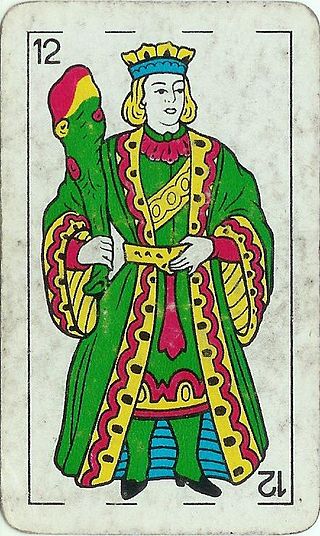
The King of Wands, or King of Batons, is a card used in Latin-suited playing cards which include Italian, Spanish, and tarot decks. It is part of what tarot card readers call the "Minor Arcana".
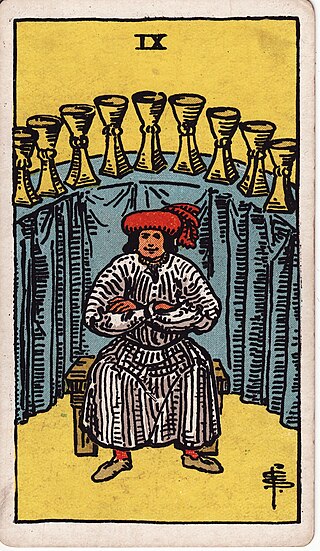
The Nine of Cups is a card used in Latin-suited playing cards which include tarot decks. It is part of what tarot card readers call the "Minor Arcana".
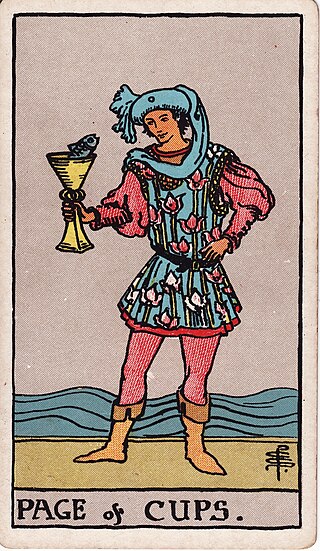
The Page of Cups is a card used in Latin-suited playing cards which include tarot decks. It is part of what tarot card readers call the "Minor Arcana"

The Knight of Cups is a card used in Latin-suited playing cards, including tarot decks. It is part of what tarot card readers call the "Minor Arcana".

The Ten of Swords is a Minor Arcana tarot card.
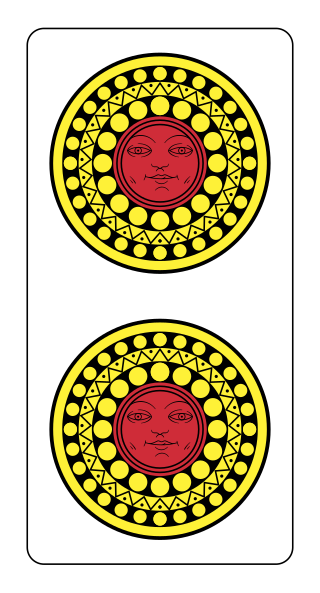
The Two of Coins, or Two of Pentacles, is a card used in Latin-suited playing cards which include tarot decks. It is part of what tarot card readers call the "Minor Arcana."

Eight of Coins is a card used in Latin-suited playing cards which include tarot decks. It is part of what tarot card readers call the "Minor Arcana"

The Queen of Coins, also known as the Queen of Pentacles, is a card used in Latin-suited playing cards. It is the queen from the suit of coins. In tarot, it is part of what tarot card readers call the "Minor Arcana".
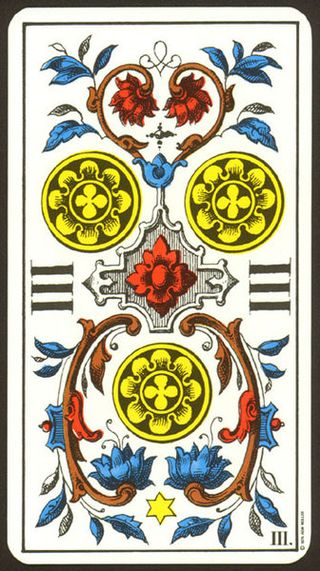
The suit of coins is one of the four suits used in tarot decks with Latin-suited cards. It is derived from the suit of coins in Italian and Spanish card playing packs.

The Ace of Wands is a tarot card of the Minor Arcana, arcana being Latin for mysteries. The cards of the Minor Arcana are considered to be lesser compared to the Major Arcana because they discuss the minor mysteries of life, less important archetypes. Modern tarot readers interpret the Ace of Wands as a symbol of optimism and invention.

The suit of cups is one of four suits of tarot which, collectively, make up the Minor Arcana. They are sometimes referred to as goblets and chalices. Like the other suits of the Minor Arcana, it contains fourteen cards: ace (one), two through ten, page, knight, queen and king. Historically, the suit represented the First Estate. Tarot cards were originally designed for card play and are still used throughout much of Europe to play various Tarot card games. However, in English-speaking countries, where the games are largely unknown, Tarot cards came to be utilized primarily for divinatory purposes. In modern card games, the equivalent suits are Hearts or Cups.

The suit of swords is one of the four suits of the Minor Arcana in a 78-card cartomantic tarot deck. It is derived from the suit used in Latin-suited playing cards, such as Spanish, Italian and Latin-suited tarot decks. Like the other tarot suits, it contains fourteen cards: ace (one), two through ten, page, knight, queen and king. Occultists claim that the suit represents the Second Estate.

Tarot games are card games played with tarot packs designed for card play and which have a permanent trump suit alongside the usual four card suits. The games and packs which English-speakers call by the French name tarot are called tarocchi in the original Italian, Tarock in German and similar words in other languages.

The Fool is one of the 78 cards in a tarot deck. Traditionally, it is the lowest of the 22 trump cards, in tarot card reading called the 22 Major Arcana. However, in tarot card games it developed to be not one of the trump cards but a special card, serving a unique purpose by itself. In later Central European tarot card games, it re-developed to now become the highest trump. As a consequence and with respect to his unique history, The Fool is usually an unnumbered card with a unique design; but sometimes it is numbered as 0 or more rarely XXII. Design and numbering-or-not to not clearly indicate its role as a trump or special card in the specific game.




















